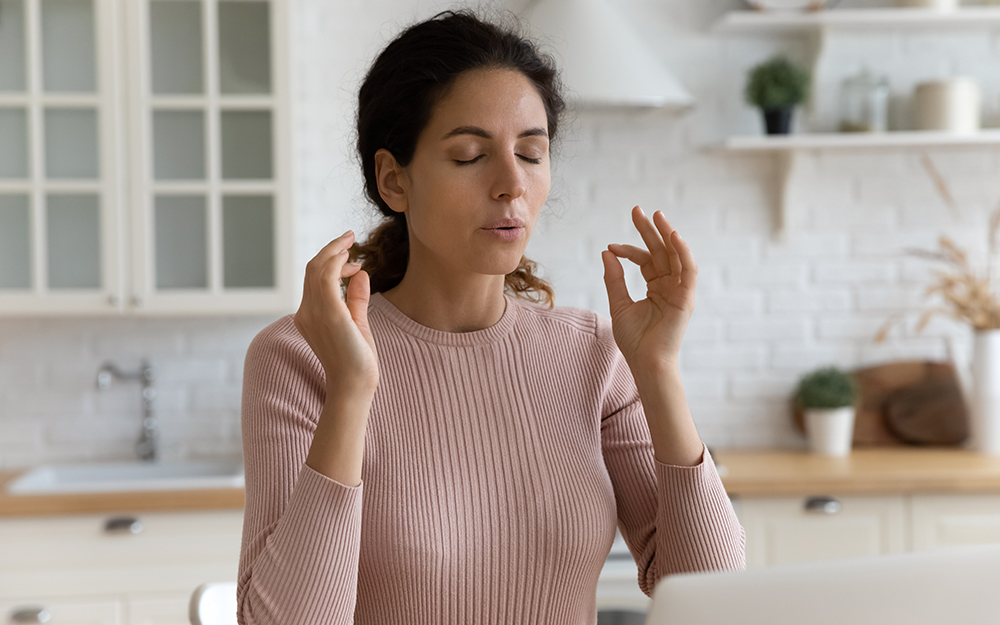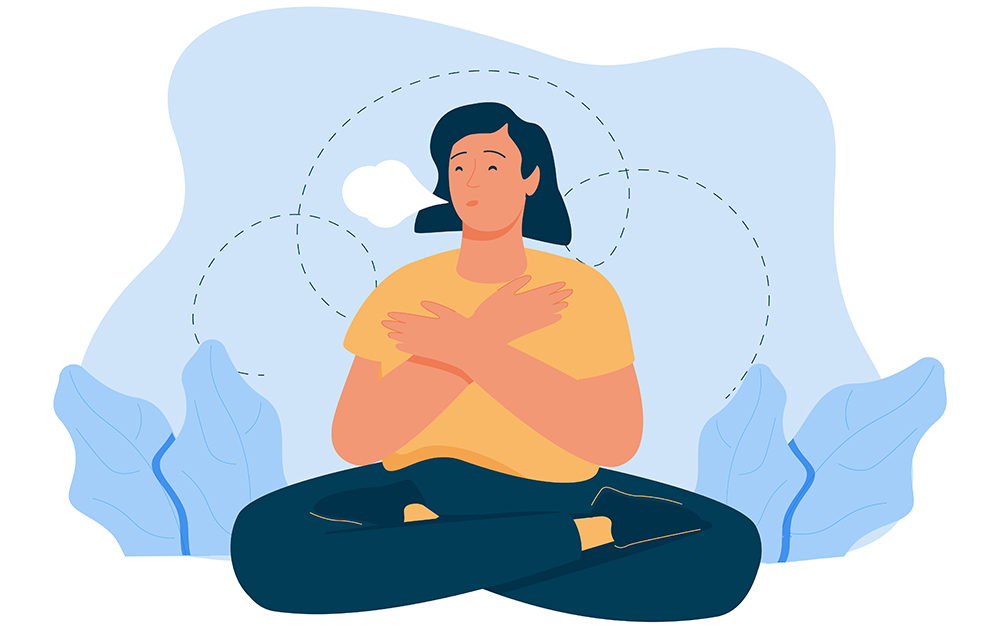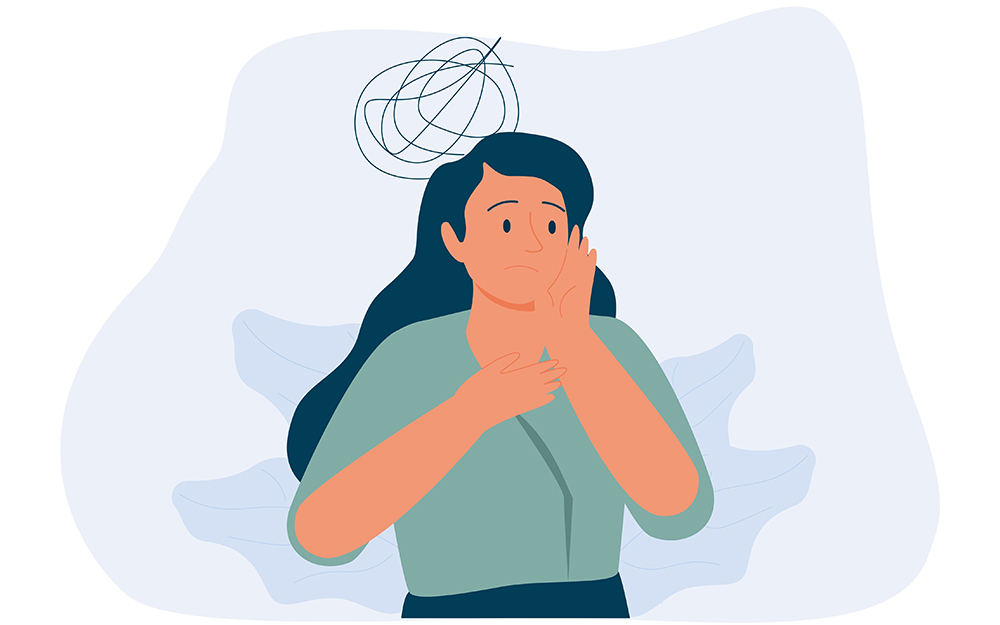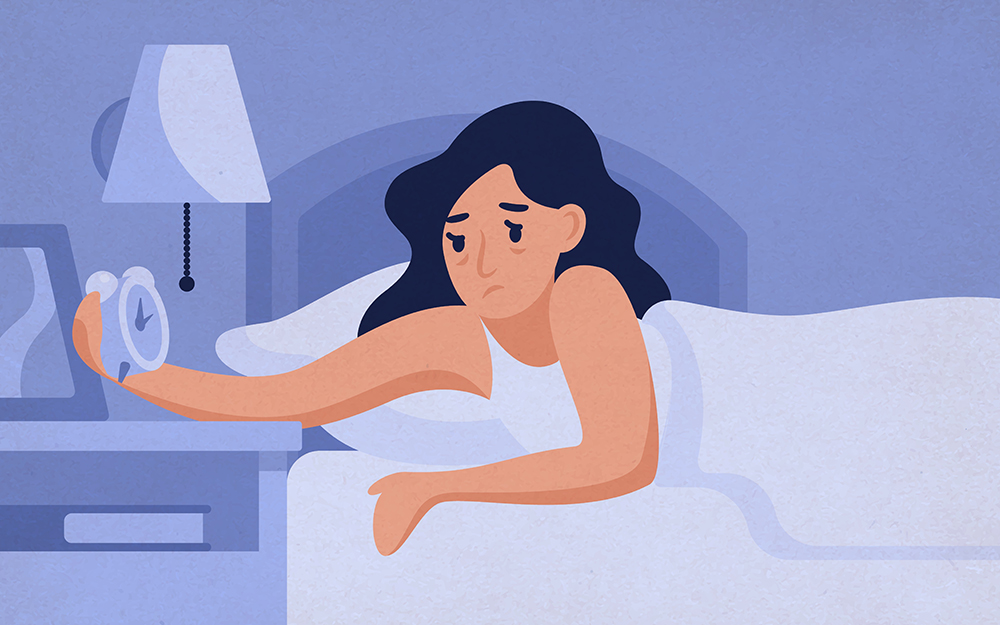It’s all too easy to lose yourself in the stresses and anxieties of our increasingly busy lives. And sometimes it can be difficult to know how to ease these overwhelming feelings, especially at the end of the day when you’re trying to sleep.
Fortunately, there is a wealth of expert information out there aimed at improving the nation’s wellbeing. One quick and easy method you may not have heard about that can help regulate these emotions during periods of stress is the technique known as ‘finger breathing’.
What is finger breathing?

Finger breathing is a form of self-hypnosis that can be used to bring you back into a calmer and more rational state of mind during times of anxiety.
It involves a combination of touch and controlled breathing, where you go through a number of finger holds and hand movements while focusing on inhaling and exhaling with a relaxed breath.
Clare Longstaffe, a leading hypnotherapist at charity Cavendish Cancer Care, has developed a number of different finger breathing techniques to help people with a diagnosis and their loved ones coping with the impact of cancer.
Cavendish Cancer Care is an independent charity dedicated to caring for people whose lives are affected by cancer.
Mattress Online, through its partnership with Cavendish, explains how you can use finger breathing to bring yourself back into a calmer state of mind during times of anxiety, including at bedtime.
Do I really want to hypnotise myself?
Finger breathing has been described as a form of self-hypnosis. Many misconceptions surround the term ‘hypnotherapy’ and the effect it can have on the body.
In reality, hypnotherapy is simply a way of allowing yourself to become more aware of how your thoughts and emotions have a physical effect on your body and breathing, and vice versa.
We can use this heightened awareness to help our breathing guide our thoughts to a calmer and more rational state. Techniques such as finger breathing aid this process.
Clare, who has years of experience using hypnotherapy to treat pain, fears and anxiety, explains:
“The most common concerns people have before hypnotherapy are that they won’t be in control and that they can’t be hypnotised. The truth is that you control your own relaxation into a trance, which is a pleasant, day-dreamy like state. The therapist is just a facilitator.”
When it comes to self hypnosis, Clare adds: “What’s even more wonderful is that you can learn to facilitate your own relaxation into this trance state. One of the best ways to achieve self hypnosis is through controlled breathing.”
The ability to bring yourself into a meditative state in times of overwhelming stress is a useful skill. Because it relies on someone controlling their own breathing, these techniques can be used in almost any environment to help you focus on the task at hand.
Chloe Angus, Corporate Wellbeing Manager at Cavendish, describes a meditative state as “when the mind is quiet and when your body feels relaxed with presence and focus in the brain. It can feel like time has slowed down, bringing a sense of calm”.

Finger breathing techniques
We’ve talked about the benefits of self-hypnotherapy, but how does someone actually perform these finger breathing techniques and what’s the best way to incorporate them into your day-to-day routine?
There are many different finger breathing and breath-counting techniques that are helpful for relaxation and distraction. Here is one that Clare successfully demonstrates to people at Cavendish.
Step 1:
Start by laying down or sitting in a comfortable position
Step 2:
Relax your breathing by taking a breath that is slightly deeper and slower than your normal breaths
Step 3:
Bring your fingers and thumb together in a relaxed pinched position. Then cup your other hand and loosely rest your bunched fingertips in your palm.
Step 4:
Count five relaxed breaths while keeping your hands in this position
Step 5:
Swap hands and count five breaths again.
Step 6:
Next, make a thumbs up with one hand and then wrap your other hand around your thumb.
Step 7:
Loosely hold your thumb while you count 5 relaxed breaths.
Step 8:
Swap hands and count five breaths again.
Step 9.
Repeat this process on the rest of your fingers. For example, next wrap your hand around your ring finger and hold it again for 5 relaxed breaths.
Step 10:
Repeat this process again with the fingers on your other hand, counting five breaths for each finger.
Finger breathing is just one of many forms of self-hypnotherapy that Cavendish experts recommend as a complementary therapy.
“Complementary therapy takes a holistic approach to care including physical and emotional needs. Having a greater awareness of ourselves and what we most need at different times of the day,” Chloe explains.
Why is breathing properly so important?
“To master our breath is to be in control of our bodies and minds. Each time we find ourselves dispersed and find it difficult to gain control of ourselves by different means, the method of watching the breath should always be used."
- Thich Nhat Hanh, the ‘Father of Mindfulness’
We’ve mentioned the connection between anxiety and breathing, but why is it so important?
Chloe explains that our feelings of fear — quickened heart rate, sweaty palms, shorter breaths — are very similar to how we feel when we are excited. The difference is whether or not we manage to control our breathing.
The famous 19th century magician, mentalist and musician, Robert Heller, once said: “Fear is excitement without breath.”.
The boundaries that separate our emotions are often much smaller than you imagine. It is said that to overcome fear, you simply need to take deep breaths and use the negative feelings as fuel. Conversely, just a slight change in breathing can turn a positive emotion into a more negative feeling that becomes difficult to control.

Our bodies tend to perform some automatic behaviours when stressed, such as tensing shoulders, clenching jaws and also holding our breath.
In part, this is due to our ‘fight or flight’ response, which kicks in during a stressful situation. Our body produces more cortisol (the stress hormone) to help us react, providing us with the energy we need to respond to the ‘danger’ it perceives as a threat.
In turn, we move into what Chloe describes as the ‘irrational’ side of our brain, where we can’t seem to focus on anything other than the thing that is concerning us.
Chloe explains how in order to calm ourselves, we need to move from the ‘irrational’ side of our brain to the ‘rational’ side of our brain. And this can be achieved through breathing.
“The sympathetic brain, also known as the emotional brain, is closely linked to the stress response of ‘fight, flight and freeze’. This can help keep us safe from danger and find momentum to take on challenges. But it is not helpful in the long term with physical and emotional problems including heart and gut issues, sleep problems, poor memory, learning and mood control.
“Slowing down, managing stress and breathwork all help to move us to the parasympathetic (logical) response of rest and digest.”
The way we breathe has a profound impact on our body and our physical reactions to anxious situations or thoughts.
Distract and relax
Breathing techniques work on the concept of ‘distract and relax’. They are designed to distract your mind from what is worrying you and relax your body enough so that you can focus on the task at hand, whether that be falling asleep or calming yourself in a stressful situation.
Chloe says: “We talk a lot about distraction and relaxation to promote sleep. When we are relaxed, we tell our bodies we are ready to rest. However, some of us may need extra support to do this, such as through relaxation techniques and night time routines, particularly with the fast paced lives we now live.
“This is also why a distraction element is helpful for getting better sleep. At night time, when we relax, we often find that our brain fills with thoughts — typically worrisome musings on the future or past.
“By distracting ourselves, we can prevent these thoughts from escalating and help ourselves fall asleep.”
Top tips for controlling your breath
Here Chloe offers three top tips to help you control your breathing:
- Concentrate on relaxed, even breathing
Counting the breaths keeps our brains distracted. It gives our brain a job to do when it is catastrophising, and the act of breathing relaxes us physically.
- Try not to exaggerate your breathing
Avoid putting too much effort into the ‘in breath’, as the result can feel far from relaxing, which is the opposite of what we want.
- Find out what works for you
Start with what comes naturally to you and then experiment with making the ‘outbreath’ longer, or slowing the breath. You may want to mix up the order or take more (or fewer) breaths with each finger hold. It should always feel comfortable to you.
- Remember, it’s a learning experience so it’s OK to have setbacks
There may be a tendency to overthink when first trying to find the “perfect relaxed” breath. You want to remove the stress around this and focus on what feels right for you. Take time and relax into the process rather than focusing on “getting it right”.
How finger breathing can help you sleep
There are many reasons why we might wake in the night. It could be:
- Environmental; for example, snoring, noises from outside or bright light
- Health-related, such as pain, hormones or ageing
- Stress
When we feel stressed and anxious it is often harder to fall asleep, or fall back to sleep. This can quickly snowball; we can’t fall asleep so we start stressing about being unable to fall asleep or about the amount of sleep we’re losing. It’s a cycle that many of us have fallen victim to at some point in our lives.
For stress and overthinking in particular, finger breathing is a helpful toolkit of techniques that can support you during the night.

And unlike some forms of self-hypnotherapy, you don’t need to listen along to a guided meditation. This makes it the perfect technique to perform from the comfort of your own bed.
The science behind it
Effectively controlling your breathing can not only help you relax mentally, it also promotes the release of melatonin.
Melatonin is the hormone that the body naturally produces as it winds down for sleep. It is often a natural response to the day getting darker, helping to orient your body to your circadian rhythm (becoming sleepy at night and waking up when it’s light outside).
“Studies have shown that deep slow breathing can promote the production of melatonin by increasing relaxation and encouraging our parasympathetic rest and digest response, as opposed to the sympathetic fight and flight response,” Chloe says.
The parasympathetic nervous system functions best in calmer conditions and is responsible for larger bodily functions such as resting and digesting. When we activate this nervous system, we can more easily control our emotions and gather ourselves to tackle the building anxiety. This is opposed to the sympathetic nervous system (‘sympathetic brain’), which is the quickest to respond to stressful situations or any other trigger that it deems potentially ‘dangerous’.
The act of breathing out helps us move to our parasympathetic nervous system, which is the more rational part of our brain that allows us to begin relaxing.

Most of all, Chloe is an advocate for the importance of trying to be more aware of our breathing in our daily lives:
“Our innate fight, flight stress response can cause us to automatically speed up or hold our breath in times of stress or general ‘busyness’ and most of the time we do not notice until we start to feel tension.
“In times of stress, if we can become aware of our breath and focus on slowing down and relaxing into our breath it can be helpful in moving to rest and digest. Creating the habit of giving our breath some attention at different times of day can help to manage emotions and stresses, and give us moments to pause and re-centre ourselves in the present moment.
Chloe says: “We would recommend planning to practise breathing regularly when you are not stressed, if something is familiar to us, we are more likely to remember to use it when we need it most.”


















